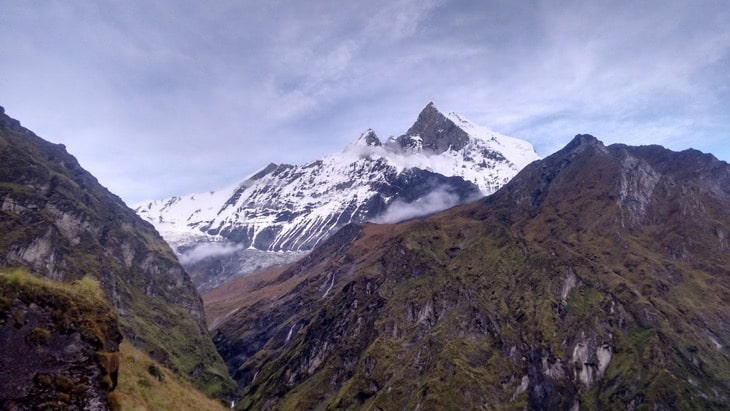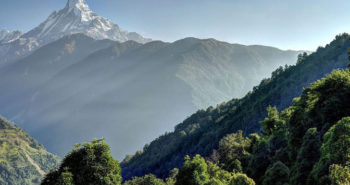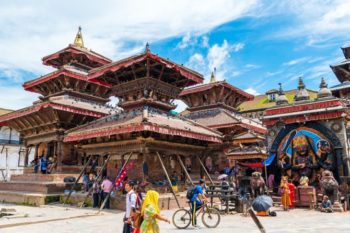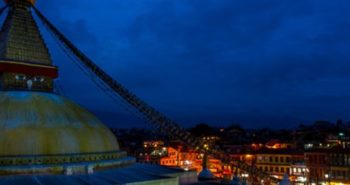Everest Base Camp Trek in April
It’s April!
It’s spring!
It is the best time for trekking in Nepal!
Aha! Are you planning to trek to Everest Base Camp in April? Well, This is the time!
Spring and Autumn are the best times to trek Everest Base Camp. April is the dry season when you can enjoy the clear views without caring much about the snowstorm. Different colored mountain flowers are in full bloom covering the lush green valley. You can see the animals and birds who come out to bathe in the warm sun. There will be fellow travelers, luggage-carrying yaks, and donkeys to accompany you to the base camp.
Green plants, colorful flowers, white mountains, blue sky. Do you need any more reason to come here?
Why trek Everest Base Camp in April?
April is spring in Nepal with blooming rhododendrons at lower altitudes and the weather is not so cold in the Everest Region. Take the temperature in Namche Bazaar for example, it can go down to 1oC (34oF) or a little below in the night but can go up to 12oC (53oF) in the day. It will be colder as you go up in elevation and warmer below Namche.
The snow should be gone from the high passes and all passes, lodges, and trails will be open
One of the best seasons in Spring!
There is nothing to ponder about while trekking in April in Nepal. It is one of the best seasons to trek Everest Base Camp
The weather is warm and pleasant in April.
Spring is in full swing, the lush green valleys, exotic mountain flowers… The scenery is priceless. You’ll be stupefied.
You will need a lot of memory on your phone or camera for the snaps.
Nepali New Year is in April
With over 60 ethnic Nepal celebrates 9 New Year. But the National New Year falls in mid-April (Usually either the 13th or 14th).
This is the day for outings, picnics, celebrations, and parties. Nepalese people love dancing and parties.
On New Year’s Eve of 2017, DJ Paul Oakenfold hosted a party at the Everest Base Camp!
You can experience the Nepali way of parties and celebrations.

Weather and Climate in April in the Everest Region
The weather will be chilly in the mornings and evenings but can be quite warm during the daylight hours. It is recommended you dress in layers to make it more comfortable for you at different times of the day.
This is now peak trekking season as the weather is so nice at this time of year.
Pros and Cons of Trekking to EBC in April
Flights in and out of Lukla will be busy and there may be delays causing a backlog of folks trying to leave the region but the weather is generally favourable for the flights. There will be, correspondingly, more people on the trails and in the teahouses. Accommodation may be hard to get sometimes, and you may have to share a room with a stranger or sleep in the dining room.
Running at full capacity, the wait for dinner may be longer. If you are in a group, if you all try to order the same items from the menus, it will go much faster! Please be patient with the kitchen staff.
The same applies if there is a delay in your flight: do not blame your guide or airport staff. The weather is out of their control!
On the plus side, it’s a wonderful time to trek to EBC and see the vast Himalayan mountains. Whether you love to trek in a small or a large group, be open to having fun and enjoying the trek. Don’t just focus on getting from A to B.
Preparing for the Everest Base Camp Trek in April
Regardless of when you go, there are always preparations to be made before any trekking expedition. Everest Base Camp is a strenuous trek and good physical fitness is required for the trek
Physical Fitness and Training
Check your fitness level. Be honest – do you think you are fit enough to trek for 12-plus days? Don’t worry if you are not because there are lots of shorter treks, even to Everest Base Camp that you can do. If you feel you can improve your fitness – do it! Spend a few weeks beforehand getting in shape. Your heart and lungs will thank you!
The best exercise is walking or hiking. Up hills if you can. Otherwise, aerobic classes and weight training are also useful.
Acclimatization and Altitude Sickness
Acclimatization is necessary on any high-altitude trek. This one is no different. We have two acclimatization days in the classic Everest Base Camp Trek – one at Namche Bazaar and one at Dingboche.
Surprisingly, the best way to acclimatize is to keep active… as in hiking for several hours on that ‘off day’. Your guide and itinerary will give your suggestions as to where to go and what to do. If you are traveling solo, please check our itinerary for information as to how best to utilize your acclimatization days.
Altitude sickness is a serious concern and should not be taken lightly.
If you develop a headache, do not panic but realize it may be the start of something more serious. Paying attention to your body is key. If you are nauseous, tired, unable to sleep, have a loss of appetite, or have dizziness you might be suffering from altitude sickness. The best way to deal with milder cases is to stay where you are. If you are very high, for example at Lobuche at 4,938m / 16,200 ft, go back down. In this case to Dingboche at 4,380m / 14,370 ft. Never go higher. Even if your group is heading off to a higher altitude, someone from your team will stay with you. If you are really unwell, or if you still feel ill the next day, go down lower.
Altitude illnesses can affect anyone, regardless of age or fitness level. So, take note of the ways to minimize the risks.
Tips to Avoid Altitude-Related Illness
Stay well hydrated by drinking a lot of water.
Eat a good breakfast and dinner in your teahouse. Do not skip these meals if at all possible. You need the energy. If you don’t feel like eating during the day while hiking, bring chocolate or biscuits with you.
Again, we stress, do not go too high without acclimatization, and do not travel too fast, even if we feel you can.
Pay attention to any headaches you or others in your group may have. Let your guide or lodge owner know if it becomes unbearable.
It is quite acceptable and normal to go down if you are unwell. Spending the night at a lower altitude will usually make you feel so much better.
It doesn’t matter how fit you are, anyone can have altitude-related illnesses. It is not a negative reflection of your fitness level.
Essential Gear and Clothing for EBC Trek in April
Here is an all-season round list of gear you will need. Although it’s spring and warmer at lower altitudes it will still be very cold at night, in the early mornings and in the evenings.
- Sleeping bag and inner sleeping bag
- Trekking boots. Please wear them. Blisters can ruin your trek.
- Trekking trousers
- Thermal leggings and tops
- Trekking tops which are easy to put on and take off and Micromesh tops to soak up the damp.
- Jackets (both down and fleece)
- Warm socks
- Gloves and a warm hat and a bandana.
- Sun hat for during the day
- Trekking poles
- Sunscreen
- Lip balm
- Moisturiser
- Water bottle
- Water purifying tablets or purifying straws for drinking water
- Sunglasses – so much better if they are large and/or wrap around
- Camera
- Whistle (in case of emergencies)
- Medical kit (including extras of your regular medicines in case of delays)
- Personal hygiene kit: toothpaste, toothbrush, shampoo, soap, sponge, towel, toilet paper
- Washing soap in case you really need to wash some clothes. You probably won’t.
- Notebook and pen. Old school Insta!
- Phone charger and power pack
Obtaining Permits and Documentation
You need two main permits to trek in the Everest Region:
Khumbu Pasang Lhamu Rural Municipality Entrance Permit: Nrs 2,000 per person.
Obtainable in Lukla or Monjo. Not available in Kathmandu.
Sagarmatha National Park Entry Permit: Nrs 3,000 per person
The permit is obtainable at the Nepal Tourism Board Office in Kathmandu or in Monjo at the gate entrance for Sagarmatha National Park. More convenient at Monjo.
Gaurishankar Conservation Area Permit is required if you are trekking in from Jiri at Nrs3,000 per person. This is obtainable at the Nepal Tourism Board in Kathmandu.
Required documents for trekking permits: you will need a copy of your passport for all permits. For the Gaurishankar Conservation Area Permit, you will also need to provide two passport-sized photographs. Pay in local currency.
Itineraries and Routes for Everest Base Camp Trek in April
Popular Route Options in April
Now that winter has gone and spring has really arrived, all the trails around Everest will be open. You can choose which trails you wish to trek. If going alone, do your homework first.
Trekking with Helicopter Tour in March
This is a great month to try out our new 5,6,7,8,9 day treks to EBC with a return journey taken by helicopter. Fast and giving you a different look at the landscape below! It is a busy season, so book any helicopter tours well in advance to avoid disappointment.
Modifications Due to Weather Conditions
Unless you are really unfortunate, there should be no changes or modifications made to your trek because of weather conditions. Except perhaps flight delays.
Major Stops and Highlights Along the Way
There are many great things to see and do on the Everest Base Camp Trek. These are just a few of the highlights:
Spending two nights at Namche Bazaar for acclimatization means there is time to explore the town and outlying areas.
Visit the Tenzing Norgay Sherpa Heritage Centre at the Sagarmatha National Park Visitors Centre. Opened in May 2023 to celebrate 70 years since the first summit of Everest, here you can find out all about Hillary and Tenzing, their expedition, and the expeditions that came before them.
The Irish Pub in Namche has real Guinness. And other pub stuff like a pool table.
Explore the best bakeries in town for that sugar rush.
If you are here on a Saturday, visit the Saturday market for local goods and handicrafts to take home for parents, siblings, and friends.
Hiking to Khumjung where Hillary set up a school for Sherpa children and learn some more about the history of this amazing man.
Go bird-watching for Nepal’s national bird, the Danphe.
Hike to Hotel Everest View for a great view of Everest. Only a short hike from Namche, this is a fantastic place to sip a cup of tea and gaze at this giant mountain.
Tengboche is a place to meet cheerful monks and light some oil lamps, The views from here are also amazing and some of the best in the region. Imagine living here? It is usual to make a small donation to the Monastery.
Lobuche is a small settlement at 4,940m/ 16,210 ft from where trekkers make their way to Everest Base Camp, which is a morning or afternoon trip from Lobuche. A simple yet exciting settlement due to its location.
Everest Base Camp. Wow! You are here at last! Was it worth the effort? Of course, it was!
Kalapattar is the best place to get fantastic views of Everest. Better than base camp even. It takes a bit of effort to climb up to the almost 5,500m height but it is well worth it when you see the panorama of mountains.
Major Highlight of the Month
Climbing Season It is not only peak trekking season, it is also the start of the climbing season. Expeditions climbing Everest don’t just turn up a couple of weeks before the optimum weather windows at the end of May. They come around two months earlier so as to acclimatize to enable them to be at their peak performance for the climb. Also, at the start of the climbing season, what are known as Icefall Doctors go in a set the ropes across glaziers and up the steep side of the mountain in preparation for the climbers to follow.
As a result, April is a busy time at Everest Base Camp. We should point out that the EBC you are trekking to is not the same as the EBC the climbers are using. Climbers do not wish to spoil their chances by becoming sick from picking something up from the hundreds of trekkers coming by. Their EBC is kind of like an isolation unit. You will, however, be able to see them – their colorful tents, their comings and goings and witness their goods coming in. You may meet a few climbers and their crew on the way up the trails such as at Namche or Lukla.
Other highlights of Trekking to EBC in April Include:
- Sunset or sunrise from the top of Kalapattar. At 5,545m this is the best point to see Everest and with the longer days, it makes it easier to climb up there at dawn or dusk.
- Finding out more about the past mountaineers at the new Tenzing Norgay Sherpa Heritage Centre in Namche.
- Exploring around Khumjung village, a short hike from Namche, where Hillary paid back to the Sherpas in terms of education and health.
- Meeting like-minded trekkers in the lodges and on the trails and the conversations had over dinner.
- And of course, the mountains themselves.
Accommodation and Logistics in April for EBC
Teahouses and Lodges During the Trek
These family-run guest houses, known as teahouses in Nepal, are a great place to relax at the end of a hard day’s trek. They offer basic, but comfortable accommodation and great meals in a convivial setting. Don’t expect luxury, although there are a few more comfortable lodges at lower altitudes. Do expect friendly owners and staff. Please do not haggle over the fact you have to pay for hot water for your shower or to recharge your electronics. Everything is difficult to import in the mountains. And these will only cost a few (3-5) dollars a day. Do you really need to shower every day anyway?
Food and Water Availability
Menus are quite good with things like curry, Tibetan bread, eggs, porridge, pancakes, and noodles on the list. Drinking water is available as boiled water, which you will have to pay for, again it is very little in relation to how much you paid to get here! Bottled water in plastic is not available on most of the trekking routes in Nepal as we become more aware of the environment.
Hiring a Guide and Porter
Beer and some spirits are available in most places, but we suggest you stick to tea and bottled cold drinks. No one wants to trek with a hangover. Save that for the final night or your return to Kathmandu.
If you are going it alone but want to take a freelance guide or porter, it will be more challenging in April to find one once you get there. It is a good idea to research before you go.
Safety and Travel Tips in April
Monitoring Weather Conditions
It’s challenging to really monitor the weather in the Everest Region. National Geographics has set up its own weather center – the Everest Weather Station Network. This is, however, primarily for very high-altitude locations, specifically on Mount Everest itself. You can check the weather through your phone though and put the setting to the lowest altitude, 4,000m. https://everest-pwa.nationalgeographic.org/
Alternatively, ask the locals what their option for the weather in the next few days is. In April the weather is pretty stable and should be good for your trek.
Coping with the Weather and Altitude
We have given you some tips regarding how to deal with altitude. The key is acclimatizing well. Do not rush from A to B. Isn’t the whole point of your trek to take in the beauty of the environment anyway?
Be aware of any headache which could develop into something more serious.
Although the weather should be stable at this time of year, you should pack for both the cold and warmer temperatures. You can never be entirely sure in the Himalayas.
Travel Insurance and Emergency Services
Your insurance should cover up to 5,000m /16,404 ft. Make sure it does. Rescue is available, in terms of helicopters or being carried down, but only if there is a way to pay for it! This is not the locals being greedy or selfish. This is them seeing thousands of visitors coming through annually and not being able to financially help everyone. If you have booked through a reputable agency, they will remind you about your insurance, and explain it more fully, before you come.
Health Posts along the Trail
There are medical facilities along the trails that help both locals and visitors. Again, as is normal in Nepal, you will be required to pay upfront for any services. For simple injuries and medicines, you should be carrying a first aid kit.
Himalayan Sherpa Hospital, at Phakding, opened in November 2022 offering outpatient and emergency services to locals in its 15 beds. More information can be found here http://www.himalayansherpafoundation.org/project/himalayan-sherpa-hospital-in-phakding/
Himalayan Rescue Association (HRA), is at Pheriche and is manned during the busy spring and autumn trekking seasons by volunteer doctors. It has been in operation since 1973, as a non-profit organisation with the objective of reducing casualties in the mountains. Their main task is to prevent altitude-related deaths among visiting trekkers and among locals. They give a talk on altitude-related problems every day at 3 pm which you are welcome to attend. As a non-profit, any donation you would like to give is also highly appreciated.
The Mountain Medical Institute (MMI) clinic is found at Namche and Dingboche. Please note the Dingboche branch is closed in the winter months, but will be open in peak trekking months, like April. Staffed by doctors trained in the unique needs of people living and travelling at high altitudes, the clinic in Namche has a basic lab, EKG, and ultrasonography.
Be Responsible
Be responsible for your own health and safety. It is unfair to assume the locals will deal with any problems that may arise because you were unprepared. That said, accidents do happen, and help will be available when it can be.
Embracing the Challenges of Trekking in April to Everest Base Camp
There are no specific hardships associated with this month in the mountains. No heavy snowfalls, no impossible-to-climb passes, just the normal day-to-day challenges of trekking in the Himalayas! The main challenge may be obtaining the accommodation you want, and having to wait an extra half an hour for dinner because there are so many other trekkers around.
Tips for Trekking in April
• Enjoy the crowds! Meeting and exchanging notes with other trekkers can be a great part of the trip.
• Mountains may be a little cloudy at times. Nature is up to her tricks!
• Flights will be busy and delays due to weather conditions are a regular occurrence during this time. Be patient. And remember to book your onward international flight a few days after your anticipated return to Kathmandu just in case.
• Planning is everything! Proper gear, proper insurance, and work on your fitness level.
• Remember to enjoy the mountains and the surroundings to the fullest.
Packing List for Everest Base Camp in April
- Sleeping Bag
- Raincoat
- Down and Fleece Jackets
- Rain cover for your backpack
- Trekking Tops
- Trekking Trousers/ Shorts
- Trekking Shoes
- Trekking Poles
- Sun Hat
- Warm Cap
- Warm Socks
- Thin Insulating Gloves
- Sunglasses
- Sunscreen
- Moisturiser
- Lip Balm
- Water Purifying Tablets
- Water Bottle
- Personal Hygiene Kits: Toothpaste, Toothbrush, Shampoo, Sponge, Towels, Toilet paper.
- Washing Powder
- Medical Kit
- Whistle
- Camera
- Mobile phone
- Portable charger
- Notebook and Pen
- Snacks
- Trash Bag
Tips for Trekking in April
Hydrate yourself
As April is warm, you might be hot after walking for hours. Take a water bottle with you and drink frequently.
We would not suggest you buy water bottles during the trek as it might cost as high as ten times. Carry the water-purifying tablets with you.
We also discourage the consumption of alcohol and meat during your expedition.
Walk at your pace
Do not feel intimidated by other people’s walking speed or their stamina. This is not a race.
Just walk comfortably at your own speed and enjoy the scenery along the way.
Some people overdo themselves and get sick the next day. They might even get altitude sickness by ascending to a higher altitude in a short time.
It is usually advised to ascend 1000m in 4 days. If you get altitude sickness, descend immediately.
Pre-booking
Even though it is not packed as in the Autumn, we would still advise you to book everything in advance. It is better to be safe.
If you book at the last moment, you might have to pay more. Also, pre-booking flight tickets are much cheaper.
So, did you book your tickets? 😉
Keep it clean
After 65 years of expeditions by thousands of tourists every year, pollution in Everest has become a major issue.
Every year, tons and tons of trash are extracted from Everest. The main water source of Sherpas is polluted.
Let’s keep the environment clean. Please bring back the trash with you.
Alternatives to Everest Base Camp Trek
Everest View Trek
Everest View Trek is perfect for people who have less time to spare for the trek. You go through a different route and reach the highest of 3956 meters.
You can watch the panorama of different mountains: Mt. Everest, Mt. Lhotse. Mt. Nuptse, Mt. Ama Dablam and Thamserku.
You can enjoy the alpine forest, and rivers, and even visit the famous Tengboche Monastery.
Gokyo Lake Trek
Gokyo Lake Trek is the 11-day expedition to Gokyo Valley.
The main charm of this trek is the world’s highest freshwater lake, Gokyo Lakes.
Gokyo Lake consists of 6 freshwater lakes. This clear water lake is of utmost importance to the Hindus and Buddhists.
You can also enjoy the view of the largest glacier in Nepal, Ngozumpa.
You will have to climb to Gokyo Ri (5,357m) to enjoy the view of Mt. Everest, Mt. Lhotse, Mt. Cho Oyu, and Mt. Makalu.


